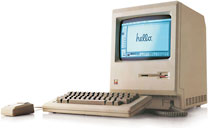 The original Macintosh wasdesigned as a closed box with no memory expansion and no card slots -no internal upgrades whatsoever. Apple even used a special Torx screwto prevent casual users from getting inside the case. The onlyexpansion was supposed to be external, using the Mac's "high speedserial bus". Those RS-422 serial ports supported speeds to 230.4 Kbps -a bit under a quarter-megabit per second. The only other port was thefloppy drive port, which supported a maximum throughput of 500 Kbps - abit over twice the speed of the serial ports. Apple's first Mac harddrive used the floppy port.
The original Macintosh wasdesigned as a closed box with no memory expansion and no card slots -no internal upgrades whatsoever. Apple even used a special Torx screwto prevent casual users from getting inside the case. The onlyexpansion was supposed to be external, using the Mac's "high speedserial bus". Those RS-422 serial ports supported speeds to 230.4 Kbps -a bit under a quarter-megabit per second. The only other port was thefloppy drive port, which supported a maximum throughput of 500 Kbps - abit over twice the speed of the serial ports. Apple's first Mac harddrive used the floppy port.
Although the 1986 MacPlus added a much faster SCSI port (over 4x as fast at 2.1 Mbps)for external devices and allowed memory expansion from the factorystandard 1 MB to 4 MB, it still had no room for an internal hard drive,nor did it have any type of expansion slot. Those two features came tothe Mac on March 2, 1987 with the introduction of the Mac SE and Mac II.
 The SE had an updated all-in-one case with two internaldrive bays - for two floppies or a floppy and a hard drive - and asingle 68000 Processor Direct Slot (PDS) for adding things likeethernet or external video. SCSI on the SE was 2.5x as fast as on thePlus at 5.25 Mbps.
The SE had an updated all-in-one case with two internaldrive bays - for two floppies or a floppy and a hard drive - and asingle 68000 Processor Direct Slot (PDS) for adding things likeethernet or external video. SCSI on the SE was 2.5x as fast as on thePlus at 5.25 Mbps.
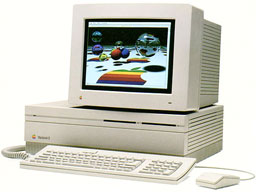 The Mac II was the first modular Mac: no built-invideo, six NuBus expansion slots, two floppy drive bays, and room for asingle 5.25" hard drive or two 3.5" drives. With a 16 MHz 68020 CPU, itwas over twice as powerful as the SE. It was also the first Mac tosupport a color display, and its SCSI was over twice as fast as the SEat 11.2 Mbps.
The Mac II was the first modular Mac: no built-invideo, six NuBus expansion slots, two floppy drive bays, and room for asingle 5.25" hard drive or two 3.5" drives. With a 16 MHz 68020 CPU, itwas over twice as powerful as the SE. It was also the first Mac tosupport a color display, and its SCSI was over twice as fast as the SEat 11.2 Mbps.
These two models changed everything. Where Steve Jobs had wanted aclosed box, post-Jobs Apple wanted users to have expansion options -just like PC users.
Steve Watkins (The PracticalMac): Expansion is one of the few areas where Steve Jobs got itwrong. He was adamantly opposed to virtually any expandability thatcould be user-installed, most likely because of his fanatical desire tomaintain absolute control over the user experience. During the designof the Apple II,Jobs suffered a rare defeat as he lost this battle to Steve Wozniak,who wanted the computer to have a myriad of expansion possibilities. Asa result, the Apple II had six expansion slots.
Wozniak later said, "I knew people like me would figure out a way touse them." Wozniak also realized that, while he had the power andinfluence at the time to force his design wishes on Jobs, "I knew itwould not always be this way." In fact, Wozniak's power and influencewere on the wane even as his design carried the day on the Apple II.The closed-system design of the original Macintosh reflected SteveJobs' ideal.
When Jobs was forced out of Apple, the Mac's design quickly morphedinto an open, expandable system. Although I doubt the Mac would haveultimately failed if it had remained closed, the opportunity for userexpansion certainly made success a little easier, particularly duringthe late 80s and 90s, a time that was the heyday of tinkering andmodding on the PC side.
Today, users have the choice of a fully-expandable Mac Pro or the relatively closedMac mini or iMac. Choice is good!
Alan Zisman (Zis Mac): To alarge extent (though not entirely!), most of the Apple product line isback to where it was - at least with the Mac Plus. But in that, they'renow in sync with the rest of the PC industry.
The Mac Plus had a (more or less) industry-standard SCSI interface,allowing connection of external hard drives, scanners, etc. - a bigplus over the original "classic" Mac's serial port. Like that originalMac, though, it lacked internal expansion slots - which were common onIBM-style PCs, earlier CP/M systems, and even Apple IIs.
Much of the improvement of desktop PCs over the 1980s and 90sfocused on improved internal expansion slots - 8-bit ISA slots in theoriginal (8086/8 PC), 16-bit ISA slots in 80286-era PCs, then amini-war for the next-generation 32-bit slots between IBM's MicroChannel and a broader industry coalition-supported EISA, ultimatelysettled in favour of something completely different: Intel's PCIspecification. Dedicated slots for video controllers went off in avariety of directions.
Larger desktop Macs offered their own expansion-slot architecture:Apple's NuBus, as well as SCSI support, both internally (for harddrives and optical drives) and externally.
When notebook computers - both PCs and Macs - became common in the1990s, they allowed limited expansion through PCMCIA (PC Card) slots,that latter evolved into the faster CardBus. Many of Apple's PowerBooksinclude these slots.
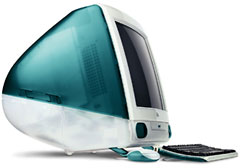 The return of Steve Jobs,though, spelled - to a large extent - a return to more limitedexpansion. The originaliMac desktop and iBook notebook were prettymuch closed systems, dropping SCSI, serial ports, and ADBkeyboard/mouse ports in favour of a pair of USB 1.1 ports. While lateriMacs (etc.) added faster USB 2.0 and FireWire ports, they lackedexpansion slots and were - like early compact Macs - difficult to openup.
The return of Steve Jobs,though, spelled - to a large extent - a return to more limitedexpansion. The originaliMac desktop and iBook notebook were prettymuch closed systems, dropping SCSI, serial ports, and ADBkeyboard/mouse ports in favour of a pair of USB 1.1 ports. While lateriMacs (etc.) added faster USB 2.0 and FireWire ports, they lackedexpansion slots and were - like early compact Macs - difficult to openup.
While different Apple notebook models have varied from one another,none has been particularly easy to fully upgrade - my 2008 Aluminum MacBook, forinstance, makes replacing the hard drive straightforward, but gettingat the RAM is a bit of a challenge. The model that replaced hadeasily-accessible RAM but a hard-to-get-at hard drive. In recentmodels, the battery is not easily replaced.
With iOS devices, Apple has gone nearly all the way to a sealeddevice. RAM and storage are inaccessible to the user, and they lack theuser-replaceable battery and removable-storage slot common to manycompetitors' products. The only external connection is via aniPod-style Dock connector, and while a large ecosystem of third-partydevices are sold for that connector, they are not compatible withnon-Apple devices.
Many consumers are happy with sealed-boxes, but they are, in theend, limiting for anyone wanting to push the limits of what thehardware can do.
Dan Bashur (Apple, Tech, andGaming): Many argue that Steve Jobs was always againstexpandability and liked to control the experience end to end. This istrue to an extent, but there are some shining examples of Macs thatwere designed after Jobs'triumphant 1997 return that have many more expansion options thanone would expect from Jobs' will to control the user experience. Oneexpansion option was purely accidental, while others were designed togrow with the Mac.
The G3 era arrived right around Steve's return and markedunprecedented power over Intel processors running at faster clockspeeds at the time. The iMac G3 quickly propelled Apple back into thelimelight. By shipping it with a tray loading optical drive (whichcould easily be swapped with various other Apple drives, including aSuperDrive), expandable VRAM (on the low-end configuration), USB, IrDA,and most notably an upgradeable processor (on a daughter card), therewere many ways the iMac could grow.
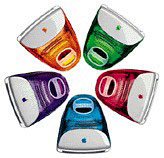 In addition, Revision A and B Bondi Blue(original) iMacs retained (by mistake) the mezzanineslot (basically a modified PCI slot), which gave way to exploitssuch as adding FireWire, different video cards such as the 3dfx Voodoo2, adding even more potential to a Mac that seemingly was closed, yetprovided much expansion. Alas, the mezzanine slot and IrDA wereeliminated with the Revision C (fruit color) iMacs,and the upgrades for the mezzanine slot revision A and B 233 Mhz iMacswere only produced for a very short time, primarily by Formac. They arenow unheard of, and would likely fetch a king's ransom from nostalgictinkerers today.
In addition, Revision A and B Bondi Blue(original) iMacs retained (by mistake) the mezzanineslot (basically a modified PCI slot), which gave way to exploitssuch as adding FireWire, different video cards such as the 3dfx Voodoo2, adding even more potential to a Mac that seemingly was closed, yetprovided much expansion. Alas, the mezzanine slot and IrDA wereeliminated with the Revision C (fruit color) iMacs,and the upgrades for the mezzanine slot revision A and B 233 Mhz iMacswere only produced for a very short time, primarily by Formac. They arenow unheard of, and would likely fetch a king's ransom from nostalgictinkerers today.
Many more G3 iMacs, including all other tray-loaders and earlyslot-loaders, continued with processors on daughter cards. The trend ofG3 processors on daughter cards continued with all G3 PowerBooks, beige G3 Power Macs and theBlue and White PowerMacintosh G3. The G3 PowerBooks all had expansion bays, and mostnotably the Pismoprovided the ability to add another hard drive using MCE's IDE harddrive expansion bay enclosure, or it could be used to run the Pismo offof two batteries at once, giving it an incredible run time in the fieldaway from a charger. The Pismo was also the first PowerBook withæonboard FireWire and an internal AirPort slot that freed up the singleCardBus slot for other expansion possibilities, such as USB 2.0 or aneven faster WiFi card. Adding to the Pismo's expansion prowess is theease of access for performing many upgrades, including the ability toswap out the hard drive in mere minutes. It truly is the mostexpandable portable Apple ever manufactured.
Processors on daughter cards would carry over to G4 Macs, but onlyon desktop towers (as well as the unique G4 Cube), and would beeliminated completely with the G5. On the G4 it allowed for singleprocessor G4s to be upgraded to dual processor machines, bootingperformance significantly.
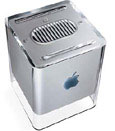 Speaking of the G4 Cube, it really was animpressive feat to have such a compact form factor with an upgradableprocessor on a daughter card and an upgradable GPU in a short AGP 2xvideo card slot! The ultimate G4 Cube configurations gave way to fastdual G4 processor cards and 256 MB graphics cards that were compatiblewith Core Image graphics cards that would not ship with a Mac foranother 2-3 years after the Cube's release. (The Mac mini is probably the closest thingto a successor to the G4 Cube, and although it's even more compact thanthe Cube, it would not offer nearly the internal expansionoptions.)
Speaking of the G4 Cube, it really was animpressive feat to have such a compact form factor with an upgradableprocessor on a daughter card and an upgradable GPU in a short AGP 2xvideo card slot! The ultimate G4 Cube configurations gave way to fastdual G4 processor cards and 256 MB graphics cards that were compatiblewith Core Image graphics cards that would not ship with a Mac foranother 2-3 years after the Cube's release. (The Mac mini is probably the closest thingto a successor to the G4 Cube, and although it's even more compact thanthe Cube, it would not offer nearly the internal expansionoptions.)
Going ever further to the extreme of minimal expansion is theMacBook Air. We have always expected and have taken for granted theability to upgrade the storage and RAM on our Macs. The Air haspartially locked things down by having the RAM soldered to the board,but the SSD (solid-state drive) remains upgradeable. In fact, upgradingthe SSD will prove to be the ultimate (and only) upgrade to the2011 MacBook Air duringit's lifecycle, since the current drive from Apple is still a secondgeneration 3 Gb/s SATA device, while OWC's incredible top-end upgradeoptions offer third generation 6 Gb/s performance - although it doesnot come cheap.
All in all, expansion has always been an exciting thing for the Mac,no matter who the scale tips for. In the battle of philosophies betweenJobs and Woz, the argument of expansion tends to resurface whenconsidering what could have been if Woz would have had his way. I forone am perfectly fine with how things turned out and understand Jobs'philosophy. By limiting expansion to a degree, it allows for fewer usererrors and less compatibility problems with third party devices,enhancing the end to end experience.
On the other hand, it does somewhat limit (and shorten) the lifecycle of a product, by fully relying on external devices attached toports, rather than internal expansion and upgrades which normallyincrease the capacity of the system itself. With the advent ofThunderbolt, many obstacles that external USB and FireWire devicescould not overcome will eventually be defeated, making Thunderbolt theultimate expansion option for today's and tomorrow's needs. We justhave to give it time to mature.
The last 25 years has been a ride of ups and downs in terms ofexpansion. I can't wait to see what the next 25 years will offer!
Dan Knight (Mac Musings):The first Mac I ever used was a Plus, and I was working at aHeath/Zenith Computers and Electronics store in Virginia Beach, VA,when the Mac II and SE were introduced. I'd only recently migrated froma Commodore 64 to a Zenith Z-158 DOS machine and remained rooted in theworld of the command prompt, but I remember a fellow employee bringingin a floppy disk with GIF images to display on the Mac II's 640 x 480color display capable of displaying 256 unique colors from a 16 millioncolor palette with its 8-bit graphicscard. It was a revelation compared to the DOS world, where EGAgraphics were state of the art at the time - 640 x 350 pixels with16 colors from a 64-color palette. While VGA would soon equal the MacII in terms of colors, that was only at a lower 320 x 200 resolution.No wonder the Mac became the choice of graphic artists who wanted lotsof colors at high resolution!
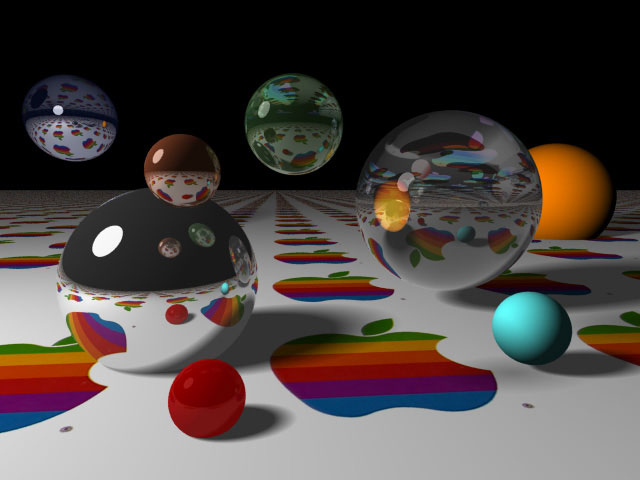
This high quality ray tracing image was widely used to show off the MacII's color capabilities.
The Mac II was the first Mac for professionals. It could use highcapacity 5.25" hard drives, which were still common in 1987, and withmultiple graphics cards, you could create an expanded desktop using twoor more monitors - all supported by the Mac OS with no third-partydrivers required.
With six NuBus expansion slots and room for 128 MB of RAM, the skywas the limit, and over time we'd have higher resolution video cards,larger monitors, and 16- and 24-bit color. Later tower Quadras andhigh-end Power Macs followed the path blazed by the Mac II 25 yearsago, as does today's Mac Pro.

 The
The  The SE had an updated all-in-one case with two internaldrive bays - for two floppies or a floppy and a hard drive - and asingle 68000 Processor Direct Slot (PDS) for adding things likeethernet or external video. SCSI on the SE was 2.5x as fast as on thePlus at 5.25 Mbps.
The SE had an updated all-in-one case with two internaldrive bays - for two floppies or a floppy and a hard drive - and asingle 68000 Processor Direct Slot (PDS) for adding things likeethernet or external video. SCSI on the SE was 2.5x as fast as on thePlus at 5.25 Mbps. The Mac II was the first modular Mac: no built-invideo, six NuBus expansion slots, two floppy drive bays, and room for asingle 5.25" hard drive or two 3.5" drives. With a 16 MHz 68020 CPU, itwas over twice as powerful as the SE. It was also the first Mac tosupport a color display, and its SCSI was over twice as fast as the SEat 11.2 Mbps.
The Mac II was the first modular Mac: no built-invideo, six NuBus expansion slots, two floppy drive bays, and room for asingle 5.25" hard drive or two 3.5" drives. With a 16 MHz 68020 CPU, itwas over twice as powerful as the SE. It was also the first Mac tosupport a color display, and its SCSI was over twice as fast as the SEat 11.2 Mbps. The return of Steve Jobs,though, spelled - to a large extent - a return to more limitedexpansion. The
The return of Steve Jobs,though, spelled - to a large extent - a return to more limitedexpansion. The  In addition, Revision A and B Bondi Blue(original) iMacs retained (by mistake) the
In addition, Revision A and B Bondi Blue(original) iMacs retained (by mistake) the  Speaking of the
Speaking of the 

